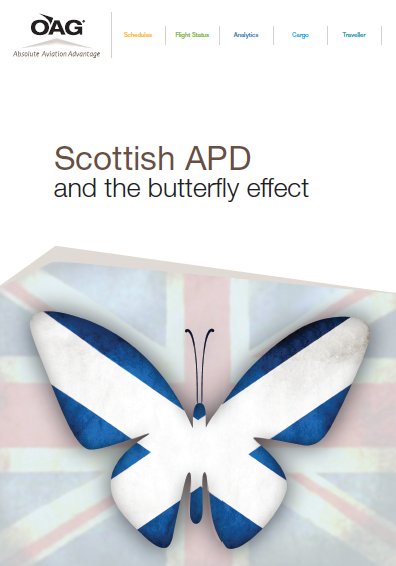In the wake of last year’s ‘no’ vote on Scottish Independence, and the recommendations of the Smith Commission tasked with taking forward devolution commitments made by Westminster, the UK Government announced in January 2015 that responsibility for Air Passenger Duty (APD) in Scotland would be devolved. An estimate in the study conducted by Edinburgh Airport put the cost of APD to Scottish tourism at more than £200 million a year. Interestingly this is less than the estimated £304 million paid to the Treasury by the 23 million passengers using Scottish airports each year, ten per cent of total UK passengers.
In a special study published for this year’s Routes Europe in Aberdeen, Scotland, aviation intelligence provider OAG has looked more deeply at the data to investigate how a reduction on APD in Scotland could impact the UK aviation sector. In APD, the UK has one of the highest passenger taxes on flying in the world, second only to Chad, according to OAG.
The case against it, made by the UK aviation industry, has been vociferous but largely ineffective. The industry has argued that it is a tax on business activity, tourism and families, not just aviation. However, the pragmatism of a handy income stream for the UK Treasury and outsourced revenue collection, via the airlines, has to date beaten the protestations of airlines and airports.
While there is not, as yet, a timescale for the reduction of APD in Scotland, the Scottish Government has said it will happen within the term of the next parliament. And as OAG notes, while the reduction in Scotland’s APD is likely to lead to some growth in demand for travel from Scottish airports by Scots, it will also encourage leakage of passenger traffic from across the border as those living in England.
Citing UK Civil Aviation Authority survey data for 2013, OAG identified that around 200,000 passengers already travelled from the north of England to fly from Scottish Airports. There are a further 500,000 passengers who live in the North East and North West of England and currently travel to East Midlands and Manchester airports to fly.
According to the report, were these passengers to decide to fl y from Scottish airports due to lower APD they would be incremental for those Scottish airports but would be a loss for English airports, and a potential loss of £7 million of APD revenue to the UK Treasury. However, in 2013, there were also 600,000 passengers who travelled from Scottish airports to fly from three airports in the north of England - East Midlands Airport, Manchester Airport and Newcastle Airport.
“So, the movement in each direction could be roughly balanced. The fact there is any leakage in either direction can be attributed to a number of factors, such as convenience of airports, flights schedules and fares. One factor for families is school holidays which are different north and south of the border,” said OAG.
But, what comes next is difficult to tell. “Quantifying the actual impact of a reduction in APD in Scotland is not straight forward,” said OAG, but it noted we can learn from Ireland to see a recent reaction to taxation changes.
“After the Irish Government scrapped its version of the passenger tax, Dublin Airport did attract passengers from the UK, including Northern Ireland, wanting to travel to the US while avoiding the hefty long-haul APD. The saving was more than £50 per person,” said OAG.
The report suggests that if Scottish airports can use the lower APD to leverage advantage, attracting new flights or even winning air services away from other UK airports, then the reaction from other regions may be much stronger than seen to date. “Could Wales and Northern Ireland ask for the same? What about other regions and even cities?” it questions.
Last September David Cameron pledged to give Manchester more autonomy and that has been followed up by announcements to hand over control of the local health budget and in the most recent budget Manchester has been granted permission to retain 100 per cent of growth in business rates. This could ultimately see Manchester add devolution of APD to its wish-list as part of a ‘northern powerhouse’ strategy?
Once regions have control of APD there is only one direction for it, downwards, says OAG. “Inevitably airports, cities and regions will seek the competitive advantage that lower air travel costs bring, and the UK is likely to see yet more redistribution of passengers around its regional airports, rather than a boost to overall UK air passengers,” said the report.
What will remain, said OAG, is APD as a tax on the south east but it could at least have the unintended side effect of redistributing traffic to regional airports which have capacity to grow while the industry waits for much needed capacity in the South East of England. “The motivation for devolution of APD to Scotland may have been electioneering but the end result could just possibly be positive for the whole air transport industry,” it added.
To what extent Air Passenger Duty (APD) will be reduced in Scotland is not yet clear, but the expectation is that this may be by up to 50 per cent, giving Scotland’s airports and airlines a clear advantage over other regions. In its report ‘Scottish APD and the butterfly effect’ data intelligence provider, OAG, offers an informed insight into the topic.
You can view the full report here





